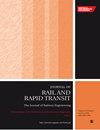基于超声导波的高速道岔开关轨底探伤研究
IF 2.1
4区 工程技术
Q3 ENGINEERING, CIVIL
Proceedings of the Institution of Mechanical Engineers Part F-Journal of Rail and Rapid Transit
Pub Date : 2024-09-07
DOI:10.1177/09544097241281759
引用次数: 0
摘要
道岔开关钢轨断裂检测是目前铁路运输领域的一个严重问题。导波检测作为一种无损检测方法,是研究这一问题并寻找合适解决方案的好方法。本文根据相速度频散曲线和波形结构选择了导波模式和激励位置。之后,使用有限元(FE)方法为道岔开关区域设计了一个模型。该模型考虑了直道岔导轨、弯股导轨、螺栓孔、间隔块和次导轨基础,并通过实验验证了模拟模型的有效性。然后,通过在钢轨基座上垂直施加 30 kHz 的激励,模拟了不同断裂状态下导波在道岔钢轨中的传播特性。结果表明,通过这种激励方法可以产生单模导波,这表明它可以作为一种有效的断裂检测手段。然后,通过分析时域加速度信号均方根(RMS)值的增长率,就可以确定直线道岔钢轨的断裂状态。这种判别方法适用于发现直式道岔钢轨底部宽度为 5 毫米或以上、与钢轨横截面平行的断裂。本文章由计算机程序翻译,如有差异,请以英文原文为准。
Research on ultrasonic guided wave-based high-speed turnout switch rail base flaw detection
Turnout switch rail fracture detection is currently a serious issue in the field of railway transportation. Guided wave detection, a non-destructive testing method, is a good way of studying this issue and looking for a suitable solution. For this paper, a guided wave mode and an excitation position were selected based on the phase velocity dispersion curve and the wave structure. After this, a model was devised for the turnout switch area using the finite element (FE) method. This model considered the straight switch rail, curved stock rail, bolt hole, spacer block, and sub-rail foundation, and verifies the validity of the simulation model through the experiment. The propagation characteristics of guided waves in the switch rail were then simulated in different fracturing states by means of a 30-kHz excitation applied vertically to the rail base. The results showed that a single mode of the guided wave could be generated by this excitation method, showing that it could be used as an effective means for fracture detection. The growth rate of the root-mean-square (RMS) value of the time-domain acceleration signal could then be analysed to identify the state of fracture in the straight switch rail. This discrimination method is suitable for finding fractures parallel to the rail cross-section with a width of 5 mm or more at the bottom of the straight switch rail.
求助全文
通过发布文献求助,成功后即可免费获取论文全文。
去求助
来源期刊

CiteScore
4.80
自引率
10.00%
发文量
91
审稿时长
7 months
期刊介绍:
The Journal of Rail and Rapid Transit is devoted to engineering in its widest interpretation applicable to rail and rapid transit. The Journal aims to promote sharing of technical knowledge, ideas and experience between engineers and researchers working in the railway field.
 求助内容:
求助内容: 应助结果提醒方式:
应助结果提醒方式:


